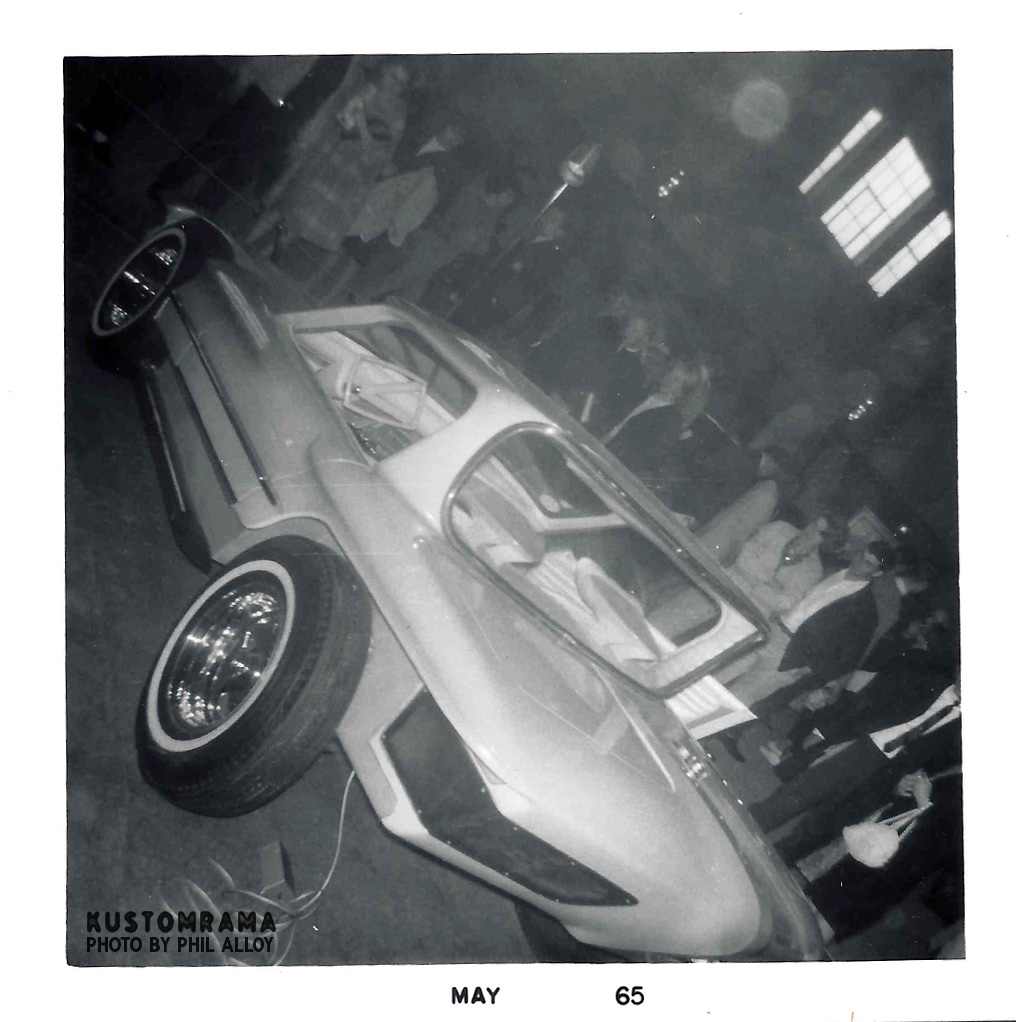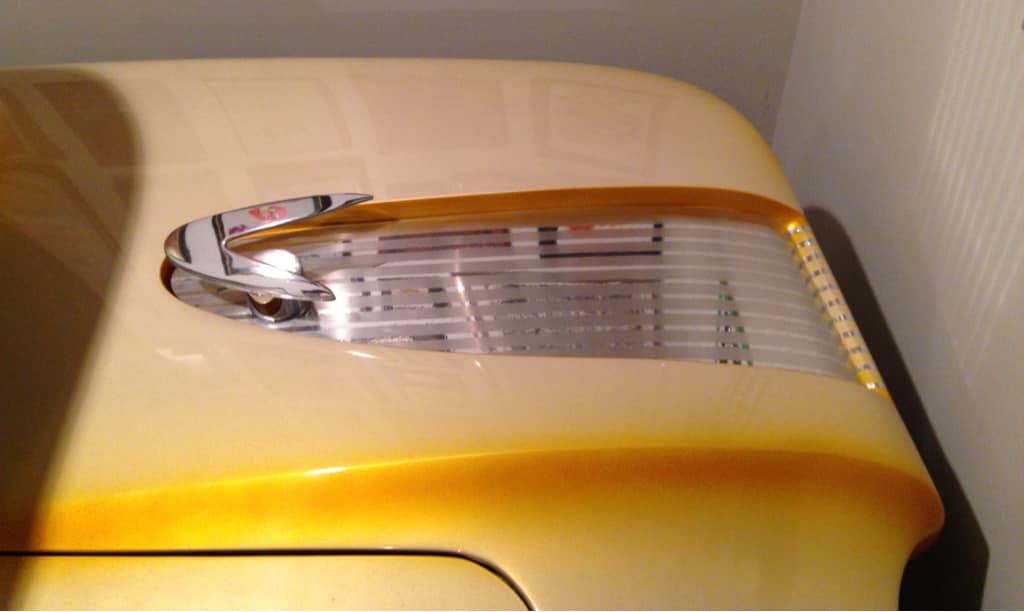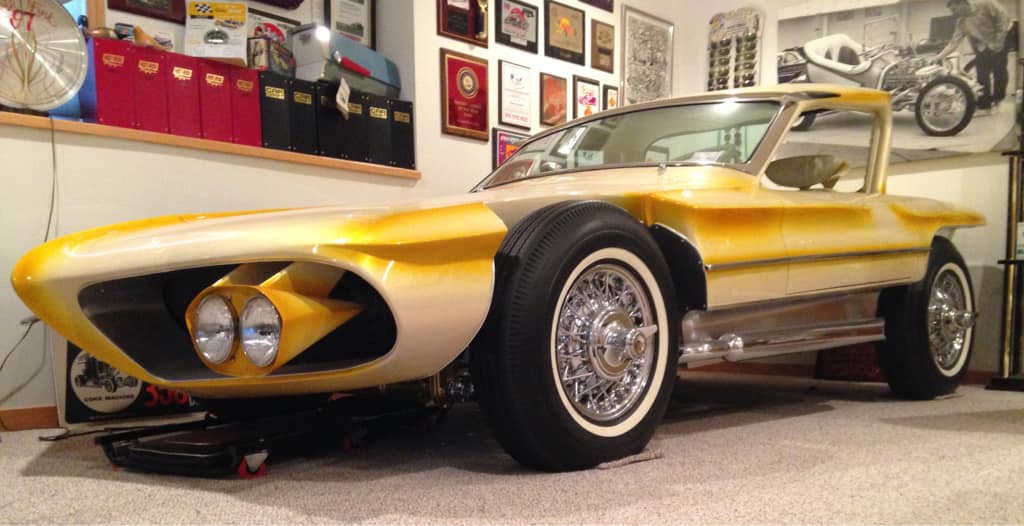Car Craft Dream Rod - Bill Cushenbery
Traditional Kustom Hot Rod and Vintage Culture and design :: Mild & radical Custom cars database :: Concept Custom Car
Page 1 sur 1
 Car Craft Dream Rod - Bill Cushenbery
Car Craft Dream Rod - Bill Cushenbery

The Car Craft Dream Rod was designed by the staff of Car Craft Magazine in 1961. The first drawings of the car appeared in Car Craft October 1961. In 1963 Bob Larivee of Promotions Inc with the approval and help of Car Craft Magazine commissioned Bill Cushenbery to build the Dream Rod. Bill approached Cushenbery to build the car after he had seen the Silhouette at the 1963 Grand National Roadster Show.[2] The car was completely custom made using some production car pieces. Bill built the car on a 1952 Jowett Jupiter chassis using a VW torsion bar in front. The frame was originally done in gold metalflake. The front fenders and doors were taken from a 1960 Pontiac, upper rear quarter tops are from a 1960 Chevrolet Corvair, the windshield and top are from a 1953 Studebaker, and the rear window is a rear window from a 1957 Borgward Isabella Sedan turned upside down. Inside, the car featured a 1958 Mercury dashboard restyled with a 1959 Lincoln ashtray. The car got its power from a 289 Ford engine. The Dream Rod was completed late in 1963, and went on from Bill's shop to tour the custom car scene. Bill had preserved the flavor of the original drawings during the build, but had also felt free to vary many of the details. As only two dimensions can be shown on paper, things began to look different when they were tried in the three dimensions of sheet metal, so Bill felt he had to do some modifications in order to make the car look as good as possible. The Dream Rod carried the electric control system that Bill Cushenbery had developed for the Silhouette a step further into the future. On the Dream Rod they were operated with a remote control "black box". The remote control led to a bit of sport, and while the car was under construction Bill would occasionally slip across the street to a coffee shop, taking the control box with him. As he enjoyed a sip of black brew, he'd casually flip a switch and punch a button. All sorts of havoc would go on back at the shop. A workman sanding down a body panel would suddenly be confronted with a popping hood or a flapping door.

In 1966 the Dream Rod was sold to the ISCA which commissioned a substantial revision to the car's styling. Called the Tiger Shark, the car wasn't as successful as the first iteration. New alterations on the car included a hood scoop, the side roof scoops were closed, the trunk lid was eliminated, the rear was stretched 6 inches, the rear window, grille opening and front fenders were also modified.
In 2005 Mark Moriarity bought what was left of the Tiger Shark from Dennis Pallen of Milwaukee. Mark is currently restoring the car back to its first version. After 3 years of hard work, Mark could finally present the fully restored Dream Rod in January 2009. The car made its debut at the HAMB.

article original:
http://www.kustomrama.com/index.php?title=Car_Craft_Dream_Rod
Dernière édition par Predicta le Dim 4 Aoû - 17:18, édité 3 fois
 Car Craft Dream Rod - Bill Cushenbery
Car Craft Dream Rod - Bill Cushenbery

The Car Craft Dream Rod was built by the famed customizer, Bill Cushenbery, for Car Craft magazine which carried a full feature on the finished car. Built from a wide array of parts (including several body panels from a 1960 Pontiac and a 1961 Corvair!), the fogged candy/pearl white/yellow custom was powered by a Ford 289 and was a wild hit on the custom car show circuit. It was popular enough that MPC issued a faithful 1/25 scale kit of the car. A few years after it was built, it was sold to the ISCA which commissioned a substantial revision to the car's styling. Called the Tiger Shark, the car wasn't as successful as the first iteration, the car made the show car circuit and was the subject of a revised MPC kit. Now, the car has been acquired by a new owner who is restoring the car to its original configuration. Thanks to Dick "Fuzzy" Fuerholzer for the restoration photos presented here, and thanks to famed custom car restorer Mark Moriarity for the photos of the Tiger Shark before he started the retro-restoration of the Dream Rod.

article original:
http://www.customclinic.com/fullcust/Cushenbery/ccdr/ccdr.html

Dernière édition par Predicta le Dim 4 Aoû - 17:13, édité 3 fois
 Re: Car Craft Dream Rod - Bill Cushenbery
Re: Car Craft Dream Rod - Bill Cushenbery
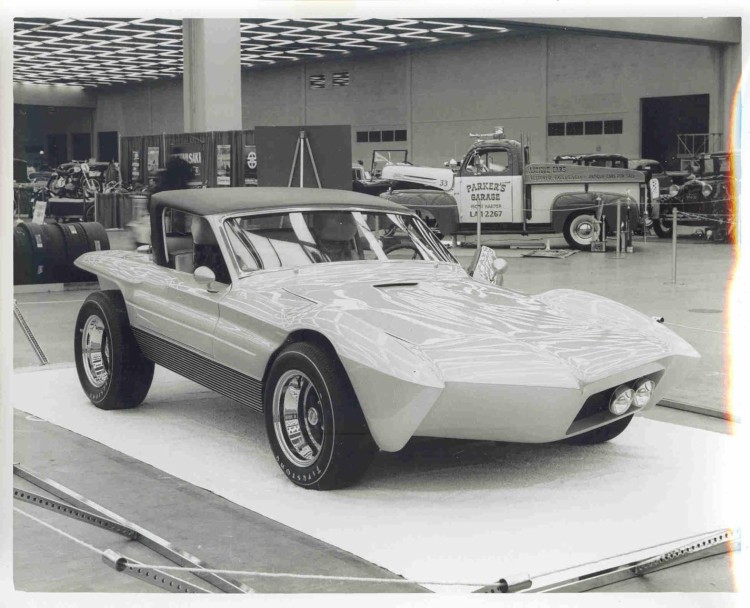
The idea that good old tin is getting rare is nothing new. In fact, if you go by the December '61 Car Craft, it's at least 48 years old.
In that issue, industrial artists Bob Hubbach and Chuck Pelly forecasted the shrinking donor pool by stating that the bottom was practically nigh. "...Not every custom-car enthusiast can find the mint-condition '27 T or Deuce body to start with," they began.
They drew up a hot rod with a body made from existing late-model body panels and it looked a lot more modern than the then-new body parts from which it was made. Christened the Dream Roadster, their idea straddled a very fine line between old-timey hot rods and the sports cars that threatened to take their place. At the very minimum it forecasted how we may build hot rods in the future.
The article had the flair of a formal proposal-not coincidental since Hubbach and Pelly were studying auto design at Pasadena's Art Center School of Design (in fact, among other things Pelly went on to found Designworks/USA, now BMW's in-house design shop). What was coincidental was that the Dream Roadster was one of a few magazine experiments that grew wings. "I thought it would make a great new feature car," Bob Larivee Sr. revealed.

Larivee Sr., for those who don't know, is the father of Promotions Inc., the company in charge of various indoor car shows, most notably the Detroit Autorama. Over the years the company commissioned various builders to create show cars that it displayed at events. Just about the time the Car Craft article came out, he bought a show car, Bill Cushenbery's El Matador.
Though El Matador wasn't built specifically for Promotions, Inc., "I really liked the work he did," he said. "I thought he was a great craftsman and a good designer, and although that car (the Dream Roadster) was already designed I thought he'd be the guy to build it."
By that point Cushenbery was an icon. After cutting his teeth at Daryl Starbird's Wichita shop, he hitched west, opened his own shop, and gave his maestro a run for his money. Chopped, sectioned, channeled, and adorned with peaks and scoops, El Matador, formerly a '40 Ford coupe, was like an earthbound spaceship. Its Candy Red paint, founded on a basecoat that faded from tan to gold, was the iridescent cherry on an outlandish sundae.

In a sense Cush was going backward by taking the Dream Rod job: about the time the Car Craft article appeared, Cushenbery unveiled The Silhouette. A sneaky bubble-topped job designed by industrial artist Don Varner, it featured a body that Cushenbery shaped entirely from flat sheet.
Despite that, Cushenbery and "Dutch" Waymire followed the Car Craft directions to an uncanny degree. Working from the proposed '60 Pontiac and Corvair parts, they sectioned it to match the design.
The Dream Rod appeared in several magazines, most notably Car Craft (twice) and Promotion Inc.'s own publications, including Showtime. Scale model maker AMT immortalized it as the Dream Rod and MPC followed suit when it became the Tiger Shark. Mike Scott built this particular model from one of the vintage AMT kits.

The Dream Rod appeared in several magazines, most notably Car Craft (twice) and Promotion But the deviations were what made Cushenbery's version stand out. Renegades in the early '60s were breaking all the rules, among them, symmetry. In the Dream Rod's case, Cushenbery reassigned the hood and nose peak to the passenger side and framed one oversized grille opening on the driver side. Rather than a tonneau and exposed spare, the rear featured a decklid and offset cove.
The proposal acknowledged a hardtop, however, the plans didn't specify a windshield or skin. Pulling from the same production-car idea, Cushenbery culled a top from a '53 Studebaker Starliner. He formed the side window openings with 2-inch steel tubing and scalloped their outer edges to create scoops. He used the rear window from the unlikeliest of sources: a '54-61 Borgward Isabella town sedan, which went in upside down. Naturally the top transformed the Dream Roadster into the Dream Rod.
He fabricated headrest pods that appeared to grow from the package tray. The car's already tight constraints forbade the larger Corvair seats, leaving Cushenbery to section a pair from a Triumph TR-3. He fabricated the nerf bars and part of the rectangular steering wheel with oval-crosssection tubing.
Dernière édition par Predicta le Dim 4 Aoû - 17:15, édité 1 fois
 Re: Car Craft Dream Rod - Bill Cushenbery
Re: Car Craft Dream Rod - Bill Cushenbery

As outlandish as the original design was, the proposed chassis ideas remained the only untenable part. One platform married Ford Falcon clips with tubing; the other specified a labor-intensive space frame.
Ever heard of a Jowett Jupiter? Unless you're a die-hard fan of postwar Brit cars, probably not. Fewer than 700 of the roadsters were built from 1950-1954 and only 200 were exported to the states, but one met its demise somewhere near Monterey, California.
Like the AC Cobra, its curiously swoopy aluminum body sat on a large round-tube ladder frame. The torsion bar rear suspension employed the torsion arms as the upper links, an ingenious design that Cushenbery kept, however, he replaced the front suspension with a beam assembly from a Volkswagen Beetle. Original plans called for a Pontiac Tempest or an aluminum-block Buick 215, however, Ford donated a pre-production 289-a prized 271-horse K-code mill at that. It bolted to a Borg Warner T10 transmission.
As ironic as it seems for such a sublime panel shaper, Bill Cushenbery's calling card was in fact paint. The Dream Rod wore a Desert Sand Pearl basecoat with Candy Gold highlighted peaks. Bill Manger trimmed the cockpit in Pearl White Naugahyde-brand vinyl.
Adorned with a set of Kelsey Hayes T-bird wires and stylish skinny whitewalls, the Dream Rod hit the streets-at least the carpeted lanes at car shows-in 1963. The car found immediate success, and within a year AMT immortalized it in 1:25 scale.
Bob Larivee Sr. posed with his pet project, the Dream Rod, upon taking delivery of it. Note the heavy asymmetry and trademark open-topped wheelwells. "The car is deceptively small," Mark Moriarity says. "Everyone who owned it thought they could drive it." That's a show car for you.
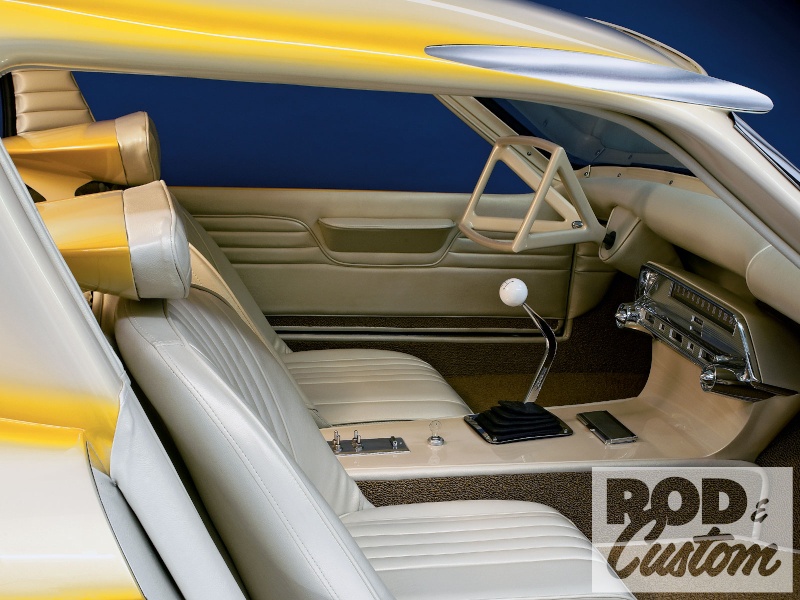
Bob Larivee Sr. posed with his pet project, the Dream Rod, upon taking delivery of it. NotPopularity being the fickle master it is, the crowds moved onto other things by 1965. Rather than retire the car, Bob commissioned Harry Bentley Bradley to tune it up. Like Hubbach and Pelly, Bradley has a portfolio most commercial artists would kill to claim. General Motors recruited the guy while he was still in school, and during his four-year tenure working for The General several magazines published his custom jobs under various pseudonyms. After designing the real Deora truck that the Alexander Brothers built for Chrysler he went to work for Mattel's fledgling Hot Wheels division where he ultimately designed 11 of the company's first 16 cars.
Bob Marianich executed Bradley's vision. Like the rest of this esteemed crowd, Marianich is somewhat unknown despite his contributions. After moving from Chicago to Detroit to work for the A-Brothers, he restored Ferraris. Later he helped designer Strother MacMinn establish CALTY Design Research, Toyota's design firm in Irvine, California. He also helped BMW develop its first American projects with Chuck Pelly, one of the originators of the Dream Rod (ironically neither realized until the formation of this story that they'd both played a part in the Dream Rod).
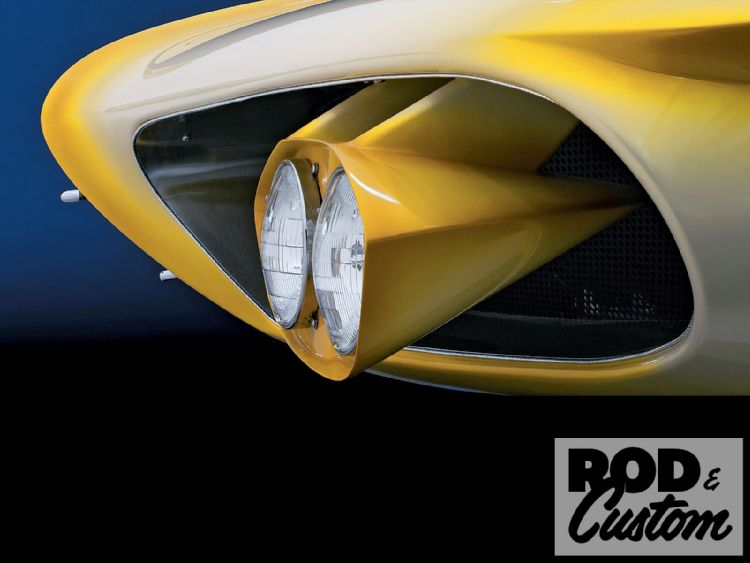
"It was quite a few mild changes," Marianich recalled. Among them, he extended the rear clip, in the process reshaping it and the taillight. He also closed up most of the Borgward rear window opening, closed off the roof scoops, lowered the back of the roof, and clad it in vinyl.
The fenders followed the nose's shape and enclosed the Dream Rod's wheelwells. The new fenders and finned panels over the coves made the car look curiously like Corvette's Mako Shark concept, an idea not lost on its creators: they named the new creature Tiger Shark.
The redesign specified a new interior, including high-backed buckets, which trimmer Fred Madley clad in a combination of wood-grained vinyl and orange and brown brocade. The rolling stock indicated a cultural shift: In place of the antiquated wires and skinny whitewalls were Cragar GT "mags" and plump Firestones.
Despite the extent of the work, the transformation took a matter of months according to Marianich. "It was a crash project for sure," he recalled.
Read more: http://www.rodandcustommagazine.com/featuredvehicles/1001rc_car_craft_dream_rod/
Dernière édition par Predicta le Dim 4 Aoû - 17:17, édité 1 fois
 Re: Car Craft Dream Rod - Bill Cushenbery
Re: Car Craft Dream Rod - Bill Cushenbery
_________________
We don't care the People Says , Rock 'n' roll is here to stay - Danny & the Juniors - 1958
 Re: Car Craft Dream Rod - Bill Cushenbery
Re: Car Craft Dream Rod - Bill Cushenbery
_________________
We don't care the People Says , Rock 'n' roll is here to stay - Danny & the Juniors - 1958
 Re: Car Craft Dream Rod - Bill Cushenbery
Re: Car Craft Dream Rod - Bill Cushenbery
_________________
We don't care the People Says , Rock 'n' roll is here to stay - Danny & the Juniors - 1958
 Re: Car Craft Dream Rod - Bill Cushenbery
Re: Car Craft Dream Rod - Bill Cushenbery
_________________
We don't care the People Says , Rock 'n' roll is here to stay - Danny & the Juniors - 1958
 Sujets similaires
Sujets similaires» SILHOUETTE - Bill Cushenbery
» Le Journal de Tintin - de 1959 à 1964 les articles sur l'automobile et la moto
» 1940 Ford custom - El Matador - Bill Cushenbery
» 1956 Ford - The Marquis - Gene Boucher - Bill Cushenbery
» 1958 Chevrolet - Limelighter - Frank Gould - Bill Cushenbery
» Le Journal de Tintin - de 1959 à 1964 les articles sur l'automobile et la moto
» 1940 Ford custom - El Matador - Bill Cushenbery
» 1956 Ford - The Marquis - Gene Boucher - Bill Cushenbery
» 1958 Chevrolet - Limelighter - Frank Gould - Bill Cushenbery
Traditional Kustom Hot Rod and Vintage Culture and design :: Mild & radical Custom cars database :: Concept Custom Car
Page 1 sur 1
Permission de ce forum:
Vous ne pouvez pas répondre aux sujets dans ce forum
 Connexion
Connexion


